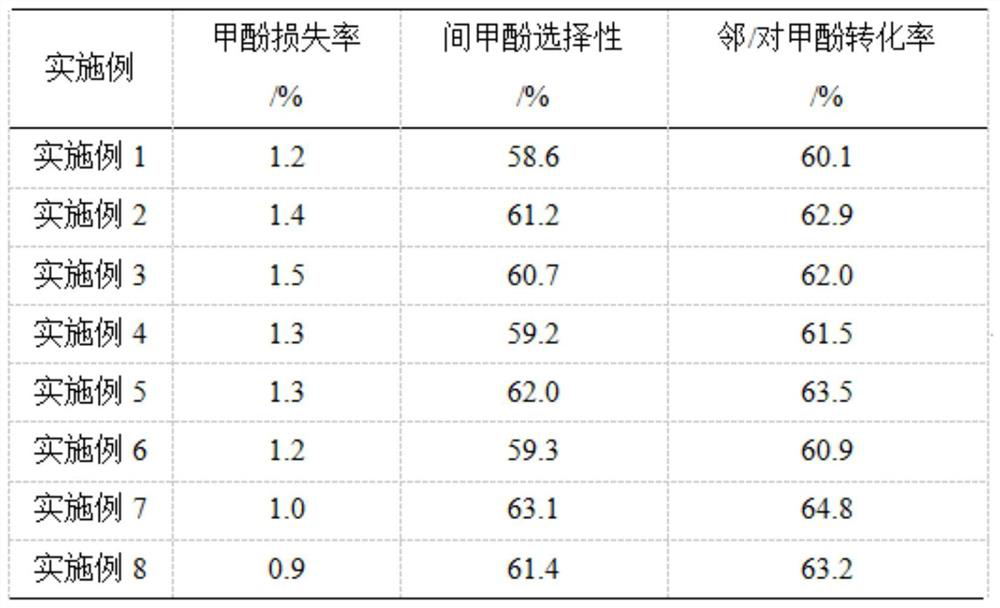Solid acid catalyst and method for producing m-cresol
A solid acid catalyst, solid acid technology, applied in molecular sieve catalysts, chemical instruments and methods, physical/chemical process catalysts, etc., can solve the problems of complex operation process, cumbersome steps, unclear specific structure of molecular sieve catalyst and its separation effect, etc. , to achieve the effects of high reaction efficiency, low cresol loss rate and significant economic benefits
- Summary
- Abstract
- Description
- Claims
- Application Information
AI Technical Summary
Problems solved by technology
Method used
Image
Examples
Embodiment 1
[0032] The o-cresol is sent as the reaction raw material into the preheater through the mass metering pump. The temperature of the preheater is set at 250°C. After sufficient preheating, it is fully mixed with the hydrogen medium. The molar ratio of hydrogen to phenol is 3:1, into the hydroisomerization reaction unit. The reaction conditions in the isomerization reaction system are reaction pressure 1.5 MPa, reaction temperature 380° C., and weight space velocity WHSV of raw material feeding 1.0 h-1. The isomerization reaction unit is pre-filled with a hydrogen-form lamellar MOR molecular sieve, and 2.7wt% of Re is added as a hydrogen active metal during the modification process of the molecular sieve. After the isomerization reaction, the reaction product is separated by gas-liquid and condensed, and the reaction product is separated through multiple rectification towers, and the unreacted converted ortho (p) cresol is recycled into the hydroisomerization process. In the rea...
Embodiment 2
[0034]After fully mixing o-cresol and p-cresol with a molar ratio of 2:1 as the reaction raw materials, they are sent into the preheater through a mass metering pump. The temperature of the preheater is set at 250°C. After sufficient preheating , fully mixed with the hydrogen medium, the molar ratio of hydrogen to cresol is 3:1, and enter the hydroisomerization reaction unit. The reaction conditions in the isomerization reaction system are reaction pressure 1.5MPa, reaction temperature 360°C, and weight space velocity WHSV of raw material feed 1.5h-1. The hydrogen-type flake HMCM-36 molecular sieve was pre-filled in the isomerization reaction unit, and 2.3wt% Re and 0.16% Pd were added as hydrogen active metals during the modification process. After the isomerization reaction, the reaction product is separated by gas-liquid and condensed, and the reaction product is separated by multiple rectification towers, and the o-cresol and a small amount of dimethylphenol generated are ...
Embodiment 3
[0036] The o-cresol is sent as the reaction raw material into the preheater through the mass metering pump. The temperature of the preheater is set at 250°C. After sufficient preheating, it is fully mixed with the hydrogen medium. The molar ratio of hydrogen to cresol It is 3:1 and enters the hydroisomerization reaction unit. The reaction conditions in the isomerization reaction system are reaction pressure 1.5 MPa, reaction temperature 380°C, and weight space velocity WHSV of raw material feed 1.5h -1 . The hydrogen-type flake HUZM-8 molecular sieve was pre-filled in the isomerization reaction unit, and 1.9 wt% Co and 0.62% Ag were added as hydrogen active metals during the modification process. After the isomerization reaction, the reaction product is separated from gas and liquid and condensed, and the reaction product is separated through multiple rectification towers, and the unreacted converted phenol and a small amount of dimethylphenol produced are recycled into the h...
PUM
| Property | Measurement | Unit |
|---|---|---|
| Specific surface area | aaaaa | aaaaa |
| Specific surface area | aaaaa | aaaaa |
Abstract
Description
Claims
Application Information
 Login to View More
Login to View More - R&D
- Intellectual Property
- Life Sciences
- Materials
- Tech Scout
- Unparalleled Data Quality
- Higher Quality Content
- 60% Fewer Hallucinations
Browse by: Latest US Patents, China's latest patents, Technical Efficacy Thesaurus, Application Domain, Technology Topic, Popular Technical Reports.
© 2025 PatSnap. All rights reserved.Legal|Privacy policy|Modern Slavery Act Transparency Statement|Sitemap|About US| Contact US: help@patsnap.com

